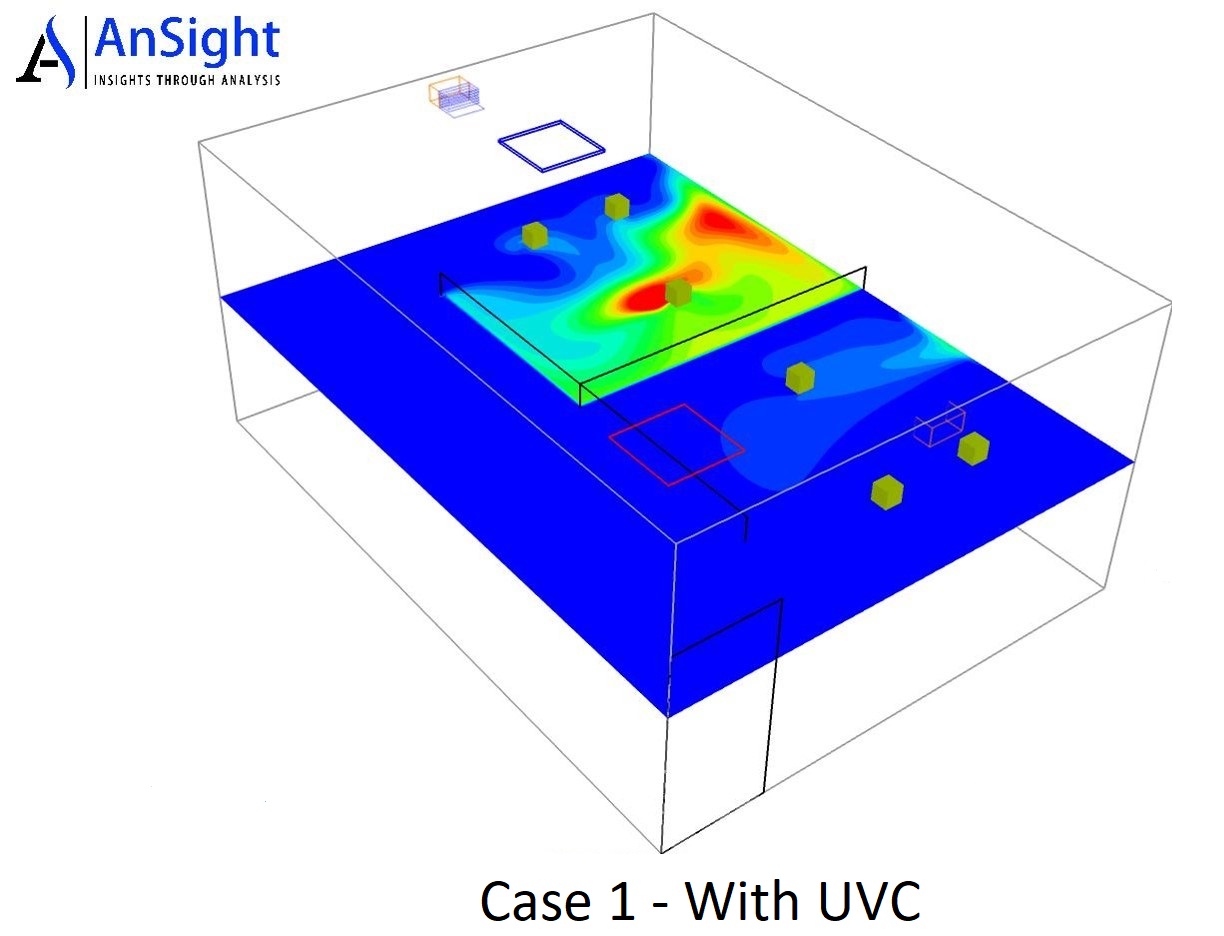Can Indoor Airflow Patterns Affect the Upper-Room UVGI Performance?
What is Ultraviolet Germicidal Irradiation (UVGI) (UV-C)?
Upper-room Ultraviolet Germicidal Irradiation (UVGI) involves the use of UVC to inactivate airborne pathogens. Wall or ceiling-mounted UVC fixtures are placed near the ceiling to generate a UVC field at 254 nm wavelength in the upper region of a room. UVC band of 200-280nm inactivates the reproduction ability of microorganisms such as viruses, bacteria, and fungi. The rate of inactivation of microorganisms depends on the type of microorganism, UVC intensity, and the duration of exposure to the UVC field. In order to limit the UVC exposure and hazard to the occupants, the UVC radiation is directed towards the ceiling and away from the occupants.
Traditionally the upper-room UVGI-UVC has been successfully employed in healthcare facilities to inactivate tuberculosis (TB) bacteria in isolation rooms and TB wards. The current COVID-19 pandemic has created renewed interest in the upper-room UVGI applications to control the spread of the SARS-CoV-2 virus. There is a popular notion that “mixing airflow patterns” can improve the performance of the upper-room UVGI systems, and therefore, the use of ceiling fans is encouraged in indoor spaces.
Why Airflow Patterns Matter?
The breathing zone which is typically located between 4 to 6 feet height from the finished floor is the most critical zone for the health and comfort of occupants in indoor spaces. Efficacy of the upper-room UVGI systems depends on the transport of infectious aerosols from the breathing zone of occupants into the upper-room UV-C zone and the transport of clean air back to the breathing zone. Such “bidirectional vertical” air movement can help in the proper inactivation of microorganisms and supply of clean air into the breathing zone. Such bidirectional air movement should occur without any short-circuiting and stagnation between these zones.
Horizontal air movement and resulting residence time of pathogens in the upper UV-C zone impact the UVC dose and the extent of inactivation. The upper-room UVGI systems form a non-uniform UV-C field – higher intensities near the fixture and lower intensities away from the fixtures. Therefore, the air movement through a high-intensity UVC zone can impart a higher dose for inactivation.
Role of Room Air Distribution
Generally the supply air is distributed through ceiling diffusers such as 4-way diffusers, radial diffusers, linear diffusers, and wall grilles. Since these diffusers induce the surrounding air into its supply air jets, they are called aspirating or induction diffusers. Location and number of ceiling supply diffusers and return grilles can affect the room airflow patterns. On the other hand laminar diffusers, which predominantly form downward airflow, cannot create the desired bidirectional air movement and may not be suitable for the upper-room UVGI application.
Thermal stratification in indoor spaces promotes upward air movement and prevents downward airflow. Intentional thermal stratification is created by the stratified air ventilation systems such as traditional displacement ventilation (TDV) or underfloor air distribution system (UFAD). In the stratified air ventilation systems the cold air is supplied near the floor. This supply air as it passes through the space sensible heat sources gets hot and accumulates near the ceiling. The buoyancy forces prevent downward air motion of the hot air. High ceilings combined with high sensible heat loads promote thermal stratification. Unidirectional vertical air movement caused by the thermal stratification is not desirable for the upper-room UVGI systems.
Factors Affecting the Airflow Patterns
Airflow patterns and the resulting flow path of airborne aerosols depend on several factors including the number, location, and type of supply diffusers in space; supply airflow rates (air change rates) and associated diffuser throws; supply air temperature; number, size, and locations of return/exhaust grilles; the location and strengths of various heat sources in a room; an arrangement of furniture and other obstructions to airflow; location, type, and capacity of air mixing devices such as ceiling fans; and importantly, the relative positions of sources of aerosols in space. A combination of strategic selection and layout of supply diffusers and exhaust grilles that promote bidirectional airflow along with appropriate capacity and location of UV-C fixtures is required to impart the suitable UVC dose for effective inactivation of microorganisms.
Computational Fluid Dynamics (CFD) Analysis
Physical testing and real-time measurements of all the parameters that affect the ventilation performance of enclosed spaces are often time and labor-intensive, if not impossible. Computational Fluid Dynamics (CFD) is a science that deals with the simulation and analysis of fluid flow, heat transfer, mass transfer, and other similar transport processes. CFD analyses provide valuable insights for evaluating the performance of the upper-room UVC applications. We have performed CFD analyses of typical office space with an upper-room UVGI system. The purpose of these analyses was to evaluate the impact of locations and number of supply diffusers and return grilles (HVAC layout) on the airflow patterns and resulting inactivation of infectious aerosols due to the upper-room UVGI system. Infection risk assessment is performed by employing the Wells–Riley model which has been extensively used for quantitative infection risk assessment of respiratory infectious diseases in indoor spaces. Ventilation effectiveness for each case is analyzed using our proprietary method of the Spread Index which computes the ratio of the volume of the space occupied by the infection level above a certain value to the total volume of the space4.
These analyses indicate the room airflow patterns induced by typical 4-way diffusers impart bidirectional airflow patterns suitable for the upper-room UVGI application, and thus, eliminate the need for additional ceiling fans. These studies further indicate that the airflow patterns resulting from the variations in the number and locations of 4-way diffusers and returns show a little impact on the overall effectiveness of UV-C.
However, these analyses show subtle differences in the nature of airflow patterns and their impact on UV-C effectiveness. It indicates that a formation of stagnant zones with recirculating airflow patterns in the vicinity of an infected individual and under the high UV-C intensity zone can be most effective in reducing the zone of a high probability of infection. Since a location of an infected individual is not known a priori, the aerodynamic containment layout with the distributed supply and distributed returns can be the most promising design layout to attain both ventilation effectiveness as well as UV-C effectiveness.
Indoor airflow patterns play a crucial role in determining the performance of upper-room UVC applications. Simply placing the UVC fixtures in a room is not enough to understand the true benefits of its application. There are no easy means to evaluate and visualize indoor airflow patterns. In such situations, CFD analyses if performed with adequate expertise, can help in optimizing the HVAC layout and strategic placement of UV-C fixtures to maximize the potential of the upper-room UVC systems.




Figure 1: CFD models of typical office space with various HVAC layouts.








Figure 2: Infection probability at the breathing zone of occupants shows significant reduction due to upper-room UVGI systems. It further indicates that HVAC layout has a little impact on the performance of the upper-room UVGI

